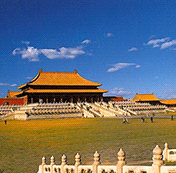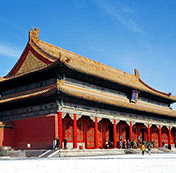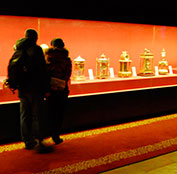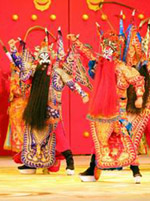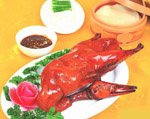|
Forbidden City (The Palace Museum)
The Forbidden City is the most magnificent spectacle, situated exactly in the heart of Beijing, was home to 24 emperors of the Ming and Qing Dynasties from 1421 to 1924. Ringed by a 52m-wide moat, the Forbidden City is China’s Largest and best-preserved complex of ancient buildings, consists of 980 surviving buildings with almost 9000 rooms encompassed by red walls.
The buildings of the Forbidden City fully embody the artistic features and style of ancient Chinese palace architecture, and can be called a masterpiece in architectural history. Besides its massive scale and historical significance, the Forbidden City strikes the imagination by its design. Its clear lines, perfect proportions, dramatic color scheme of red walls and wooden columns, white marble terraces and staircases, brilliant yellow tiles roofs and uplifted eaves, create one of the world’s most beautiful architectural complexes.
The 8-kilometer long central axis runs through the entire old Beijing city to Gate of Qianmen in the south, Bell and Drum Towers in the north. The throne symbolizing imperial power is positioned at the center of this central axis. And the Basic layout of the Forbidden City unfolds along this north-south central axis. The southern part is the outer court where the emperor exercised his supreme power over the nation. The northern part is the inner court where he lived with his royal family.
Having been the imperial palace for some five centuries, it houses numerous rare treasures and curiosities. Let’s go through the palace along the central axis starting from its south point, the Meridian Gate to the north end, the Gate of Divine Prowess. Along the route, symmetrical palace buildings greet you with distinctive scale and function.
Tourist Highlights
1. Meridian Gate (Wu Men)
Meridian Gate is the southern gate and the only entrance now to the Forbidden City. Restored in the 17th century, the Meridian Gate is a massive portal that in former times was reserved for the use of the emperor. It has five arches; the three arches are close together while the other two flanking arches are farther apart from the three central arches. Above the arches are five buildings, where the emperor of China reviewed his troops during Ming and Qing dynasties. Its superstructure is also called the “Five Phoenix Turrets”.
2. Gate of Supreme Harmony
The Gate of Supreme Harmony is the second major gate encountered when entering the Forbidden City from the south. The gate was originally built during the Ming Dynasty and burnt down in 1886 due to a fire started by a tipped lamp in the guard room. The present gate dates from the rebuilding after this fire and completed in 1894.
In Ming Dynasty, the Gate of Supreme Harmony is the location where the Emperor held morning court. And it was also used occasionally for banquets and other ceremonies.
The gate is three bays deep and seven bays wide and is flanked by two minor gates. The gate and the Meridian Gate form the north and south boundaries of a great plaza that is divided by a serpentine waterway, the Inner River of the Golden Water, which is spanned by a set of five bridges. On the north side of the gate is Harmony Square, leading to the Hall of Supreme Harmony.

3. Hall of Supreme Harmony
The Hall of Supreme Harmony is the largest hall within the Forbidden City. It is located at its central axis, behind the Gate of Supreme Harmony. Built above three levels of marble stone base, and surrounded by bronze incense burners. It was the location where Ming Dynasty and Qing Dynasty Emperors hosted their enthronement and wedding ceremonies.
The Hall of Supreme Harmony rises some 30 meters above the level of the surround square. The numbers nine and five are symbolically connected to the majesty of the Emperor. So there are cases to show this symbolism such as the hall is nine bays wide and five bays deep; the imperial Dragon Throne has five dragons coiled around the back and hand-rests; the screen behind it features sets of nine dragons.
The original hall was built by the Ming Dynasty in 1406 and was destroyed seven times by fires during the Qing Dynasty and last re-built in 1695 and completed in 1697. Together with the Hall of Central Harmony and Hall of Preserving Harmony, the three halls constitute the heart of the Outer Court of the Forbidden City.
4. Hall of Central Harmony
Behind the Hall of Supreme Harmony is the Hall of Central Harmony, which is the smallest hall (580㎡) of the three halls of the Outer Court of the Forbidden City. It is square in shape and used by the Emperor to make last-minute preparations, rehearse speeches, receive close ministers and rest before and during ceremonies.
Inside the hall, visitors will find a pair of golden unicorns standing on each side of the throne in the center. It is kind of mythical creatures and believed to know languages and events far away. They are put on the thrones to symbolize the intelligence and wisdom, also functioned as burner. The copper burners sit on both sides of the hall is for the use of heating.
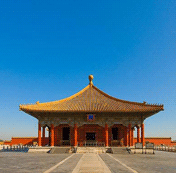
5. Hall of Preserving Harmony
The third hall, which has no support pillars, is the Hall of Preserving Harmony, used for banquets and later for imperial examinations. To the rear descends a 250-tonne marble imperial carriageway carved with dragons and clouds, dragged into Beijing along an ice path. The emperor was conveyed over the carriageway in his sedan chair as he ascended or descended the terrace.
The wing rooms on both eastern and western flanks now are explored as the exhibitions rooms. There are exhibitions exploring the emperor’s Tibetan Buddhist beliefs, ancestor worship, the imperial harem and the lives of the imperial concubines on the eastern flank. While on the west, three Great Halls exhibit treasures from the palace.
6. Gate of Heavenly Purity
Gate of Heavenly Purity is the front door to the Inner Court of the Forbidden City. Originally built in 1420 and re-built in 1655. It is five bays wide and 3 bays deep, about 16 m high. The huts to the left and right are the duty rooms and waiting rooms for ministers to be interviewed. It is an important portal connecting the inner court and outer court, separating the living zone and working zone of the emperors.

7. The Palace of Heavenly Purity
The Palace of Heavenly Purity, located at the northern end of the Forbidden City, is the largest of the three halls of the Inner Court. It is the residence of Ming and early Qing emperors, and later an audience hall for receiving foreign envoys and high officials.
The Palace of Heavenly Purity is a double-eave building, and set on a single-level white marble platform. It is connected to the Gate of Heavenly Purity to its south by a raised walkway. At the center of the Palace, set atop an elaborate platform, is a throne and a desk. A caisson is set into the roof, featuring a coiled dragon. Above the throne hangs a tablet with a right to left script of Chinese Idiom meaning “To be decent, honest and magnanimous”.
8. Palace of Tranquil Longevity
The Palace of Tranquil Longevity is a complex located in the northeast corner of the Inner Court of the Forbidden City. Construction of the Palace began on the Qianlong Emperor’s orders in 1771, in preparation for his retirement, although Qianlong never moved into the palace. Throughout the Qing period, the palace was almost never used, largely because of Qianlong’s imperial decree ordering his retirement retreat remain unaltered. It is also divided into two parts – front court for state business and back yard for living.
The back yard of the complex could be divided into three parts: eastern session, central session and western session. The eastern session includes the Belvedere of Pleasant Sounds, Palace of Celebrating Longevity, Palace of Scenery and Happiness, and two pagodas. The central session includes Hall of Spiritual Cultivation, Hall of Joyful Longevity, Bower of Well-nourished Harmony and Belvedere of Auspicious Fortune. And the western session is the garden zone.
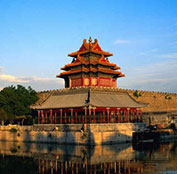
9. Clock Exhibition
The mesmerizing Clock Exhibition Hall is one of the highlights of the Forbidden City. Located in the Hall of Ancestral Worship, the exhibition contains a fascinating array of elaborate timepieces, many of which were gifts to the Qing emperors from overseas. Many of the 18th-century examples were imported through Guangdong from England; others are from Switzerland, America and Japan. Exquisitely wrought, fashioned with magnificently designed elephants and other creatures, they all display an astonishing artfulness and attention to detail.
(CNY 10; 8:30am-4:00pm in summer, to 3:30pm in winter)
10. Treasure Gallery
It lies on the north-south axis of the Palace of Tranquil Longevity Area in the northeast of the Palace Museum. It is now divided into three exhibition halls for gold, silver, pearls, jade, utensils, tea services, imperial robe, phoenix crown, daily necessities as well as furnishings of the Qing Dynasty imperial family. The first exhibition room (Hall of Imperial Supremacy) is for show of the gold, jade and tea services. The second exhibition room (Hall of Joyful Longevity) is for show of royal wearing such as robe, crowns and court beans. The third exhibition room (Bower of Well-nourished Harmony) is for show of furnishings like the globe and jade decoration.
(CNY 10, 8:30am-4:00pm in summer, to 3:30pm in winter)

11. Hall of Celestial & Terrestrial Union
The Hall of Union stands between the Palace of Heavenly Purity and the Palace of Earthly Tranquility. These three halls together constitute the centre of the Inner Court of the palace complex. Originally built in 1655, was fired in 1797 and rebuilt in the same year. It is the living place for the emperors and concubines. The hall is square in shape with a pyramidal roof. Stored here are the twenty-five Imperial Seals of the Qing Dynasty, as well as other ceremonial items, including the clocks that set the official time in the palace (first a water clock, later a mechanical clock, both still displayed in the hall).
12. Palace of Earthly Tranquility
Behind the Hall of Celestial and Terrestrial Union, the northernmost stands one of the three halls of the Inner Court – Palace of Earthly Tranquility. The Palace of Earthly Tranquility represents the Yin, opposing to the Palace of Heavenly Purity representing Yang. It appeals to the traditional Yin-Yang theory and symbolize the fitness of the Emperor and Empress.
The Palace of Earthly Tranquility is a double-eave building, 9 bays wide and 3 bays deep. In the Ming Dynasty, it was the residence of the Empress. In the Qing Dynasty, large portions of the Palace were converted for Shamanist worship by the new Manchu rulers. Thus, the front part of the hall featured shrines, icons, prayer mats, and a large kitchen where sacrificial meat was prepared. Two rooms on the eastern flank are used for the Emperor’s wedding ceremony, and two days after the wedding, the Emperor and Empress would retire to other room.
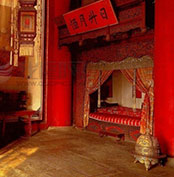
13. Treasure Gallery
The Hall of Mental Cultivation is a particularly significant building in the inner courtyard of the Forbidden City. Built originally in the Ming Dynasty and rebuilt during the Qing Dynasty, it was here that from the time of Yongzheng Emperor in the 18th century the Qing Emperors lived and ruled the Chinese Empire. Three emperors died in the Hall. The building itself has a front and a rear hall, which served as the emperor’s bedroom. In the front hall the Emperor discussed court business with his mandarins. From behind a screen in the hall the Dowager Empress Cixi made decisions on state business in the name of her son and her nephew in the late 19th century and into the early 20th century.
14. Imperial Garden
At the northern end of the compound is the delightful garden named as Imperial Garden. With ancient pines and cypresses, artificial hills and rocks, pools and pavilions, the garden is full of fine relics of the Ming and Qing dynasties. Imperial Garden was originally for rest and walking of Emperor and concubines, but it also used for reading. Initially established in 1420, Imperial Garden was restored for several times. The whole garden has a total length of 80 meters from south to north and 140 wide from east to west. The total area is 12,000 square meters.
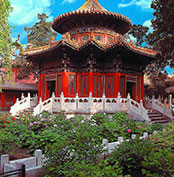
15. Gate of Divine Prowess
The structure looks like a rectangle with 31 meters in height, is the north gate of the Forbidden City. On its tower are bells and drums beaten in the morning and in the evening respectively to mark time in ancient times. The gate is the main exit for visitors now. As the back gate of Forbidden City, it was the important channel for entrance and exit. Both in Ming and Qing Dynasties, the empresses would come and go through this gate for official ceremony or rite. In 1924, Emperor Pu Yi, the last Emperor of China in feudalistic period, was expelled out of the Forbidden City through this gate.
Most of the buildings in the Forbidden City were rebuilt many times, although they maintained the original architectural style. Today, as the largest museum of cultural relics in China, the Forbidden City, also called the Palace Museum, collected and displayed some one million precious historical relics through dynasties. Listed by UNESCO as a World Cultural Heritage Site in 1987, the Palace Museum is now one of the most popular tourist attractions worldwide.
Admission Fee: CNY 60 (Apr 1st-Oct 30th) CNY 40 (Nov 1st-Mar 31st)
Opening Hours: OPEN Tuesday - Sunday
CLOSED Monday (except for national holidays and July-August)
8:30 to 17:00 Last entry: 16:10 Last tickets are sold at 16:00 (April 1st – October 31st)
8:00 to 17:00 Last entry: 16:10 Last tickets are sold at 16:00 (July 7th to August 26th)
8:30 to 16:30 Last entry: 15:40 Last tickets are sold at 15:30 (November 1st – March 31st)
Subway: Take Line 1 to Tiananmen Dong (East) or Tiananmen Xi (West) Station
Take Line 2 to Qianmen Station - Exit A/B - walk north
Bus: Tiananmen Xi Station: Bus 1, 5, 10, 37, 52, 90, 99, 205, 728, Zhuan 1/2
Tiananmen Dong Station: Bus 1, 2, 10, 37, 52, 59, 82, 90, 99, 120, 126, 203, 205, 210, 728, Zhuan 1/2
Recommended Beijing Tours:
Recommended China Tours Including Beijing:


|
|
| Other City |
|
 |
| Customer Service |
|
 |
| Toolkits |
|
 |
|



